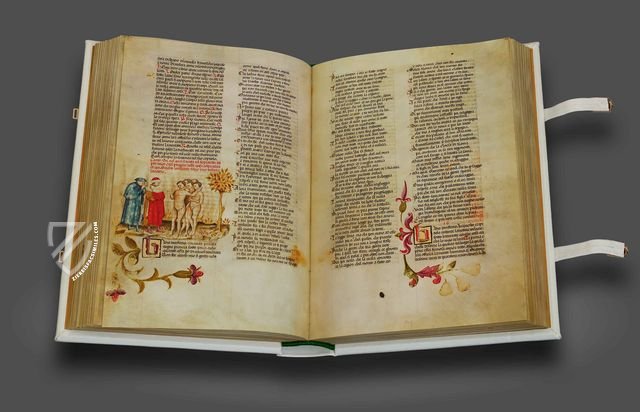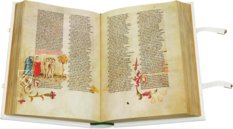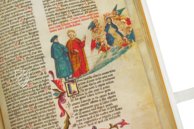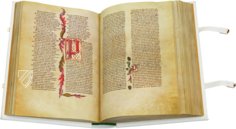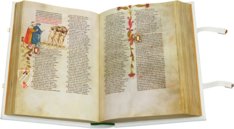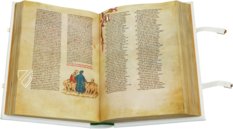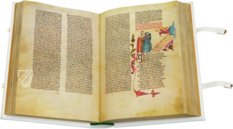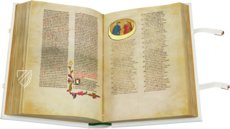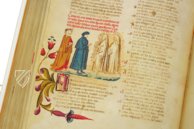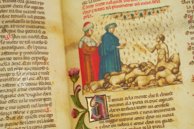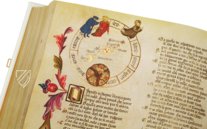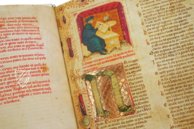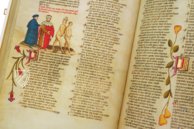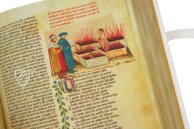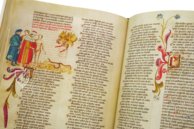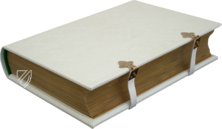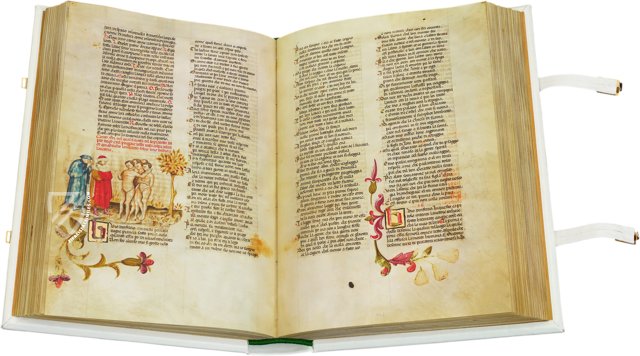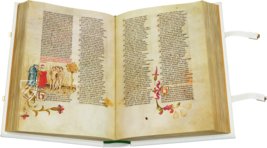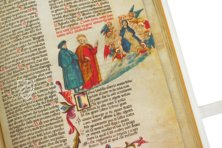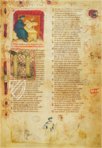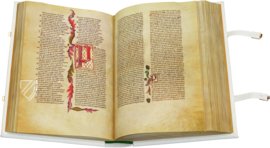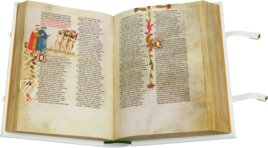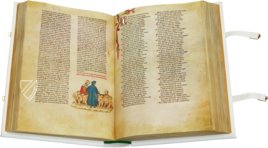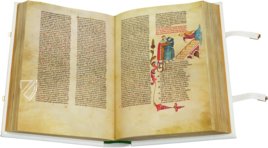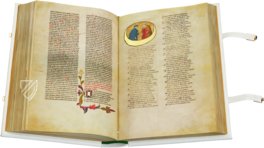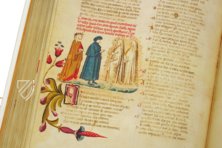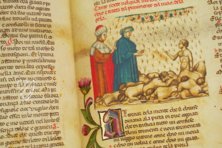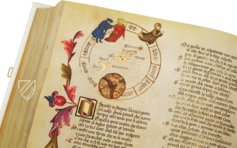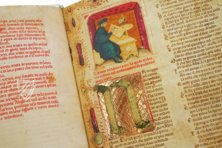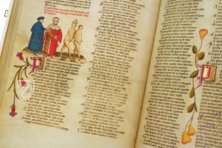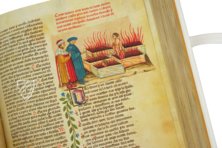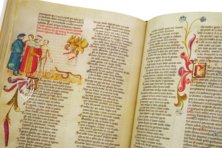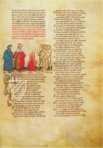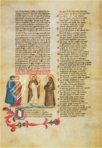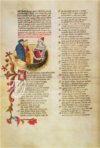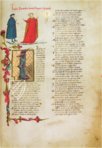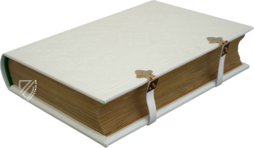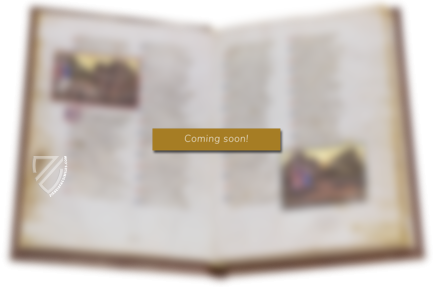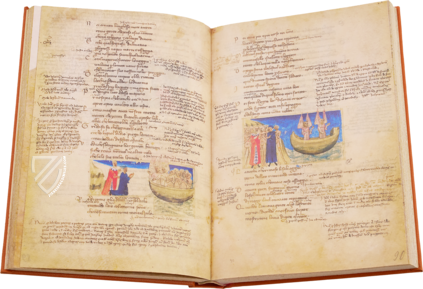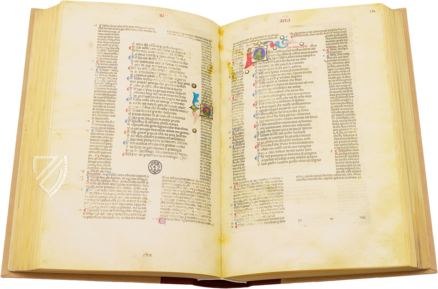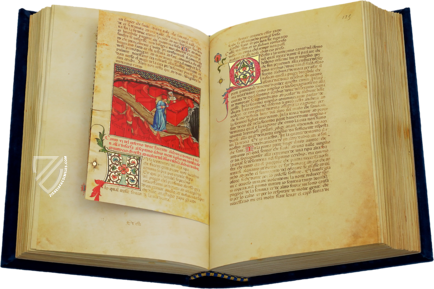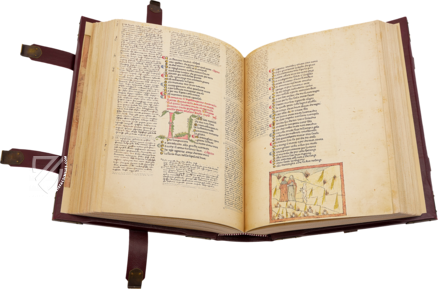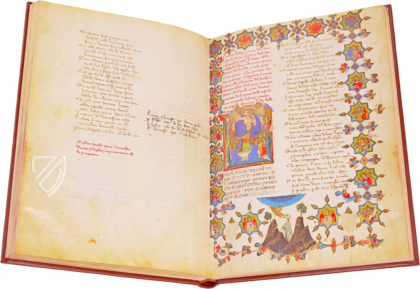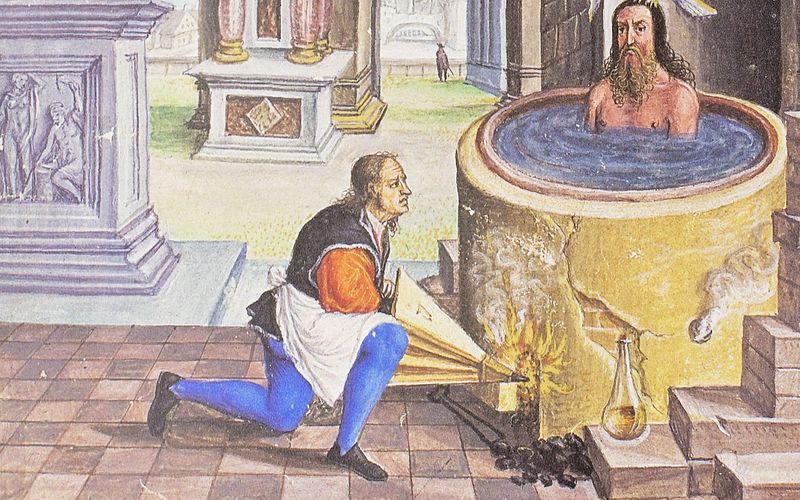Divine Comedy - Padua 67 Manuscript
(3,000€ - 7,000€)
With his Divine Comedy, Dante Alighieri (1265–1321) not only created his magnum opus ca. 1307, but also founded Italian literature. Today, countless editions of this masterpiece are in existence. One of them originates from the second half of the 14th century and aside from the important poem, contains the commentaries by Jacopo della Lana (1290–1365) and Andrea della Lancia (pre-1296 – post-1357). First, the 100 luminous miniatures, tasteful bordures, and lavish initials by Michelino da Besozza (ca. 1370 – ca. 1455) make the manuscript a magical experience. In it, the illuminator encapsulates the events of this entire text and glamorously presents them before the eyes of the beholder.
Divine Comedy - Padua 67 Manuscript
Appearing at the end of the 14th century in Italy, this 301-page edition of Dante Alighieri’s (1265–1321) Divine Comedy also contains additional commentaries by Jacopo della Lana (1290–1365) and Andrea della Lancia (pre–1296 – post–1357). This Italian vernacular work also comprises a bedrock for Italian literature and is adorned with 100 glimmering miniatures, splendid initials, and rich decorative elements by Michelino da Besozzo (ca. 1370 – ca. 1455). Since the escutcheon of the Obizzi family is to be found on the first page of the Inferno, it can be surmised that it was commissioned by or was in the possession of the family for a time.
Miniatures from the Best
The Italian Michelino da Besozzo (ca. 1370 – ca. 1455), one of the most gifted late-Gothic artists from Lombardy, was commissioned to illuminate the manuscript. He already worked for Gian Galeazzo Visconti (1351–1402) and also demonstrates all of his ability with the depictions of Dante’s work. Contrary to the many other illuminations, he did not make these in collaboration with other artists but rather alone.
Great Art in Small Format
The illuminator encapsulates the events of the entire text in 100 splendidly-colored miniatures. In order to achieve this, he decided against isolated full-page miniatures and instead chose smaller depictions, which could take up the width of a column. These smaller-format pictures are captivating with their luminosity and the frugal application of gold leaf, wherewith Besozzo skillfully emphasized its features. Corresponding to the scene were artful flowering tendrils, able to enchant with their detailed portrayal of nature.
The Book’s Unknown History
There are only two clues concerning the origin and history of the comprehensive codex. One is that it appears to havecome to the Biblioteca del Seminario in 1720 when Alfonso Alvarotti died and the library of his entire collection was bequeathed. The second reference is a coat of arms on the first page of the Inferno. In spite of heavy damage, it can be identified as that of the Obizzi family, who had connections in the area of Ferrara and Padua.
Codicology
- Alternative Titles
- Divine Comedy Cod. 67 in the Seminario of Padua
Göttliche Komödie degli Obizzi
Dante Alighieri - Divina Commedia degli Obizzi - Size / Format
- 301 pages / 34.0 × 23.9 cm
- Origin
- Italy
- Date
- Second half of the 14th century
- Epochs
- Style
- Genre
- Language
- Script
- Gothic Textura Rotunda
- Illustrations
- 100 miniatures; decorated initials with curlicues
- Content
- Dante's Divine Comedy with commentaries by Jacopo della Lana and Andrea della Lancia
- Artist / School
- Michelino da Besozzo
- Previous Owners
- Alfonso Alvarotti
Divine Comedy - Padua 67 Manuscript
Dante Meets King Solomon
In the fourth sphere of Heaven, which exists within the Sun, Dante encounters examples of Prudence, Justice, Temperance, and Fortitude from among the souls of those who illuminated the world with their wisdom. Most are philosophers and theologians like Thomas Aquinas, but King Solomon is included among them. Aquinas explains to Dante that the famously wealthy and wise monarch of the Israelites is there for his wisdom as a king, not as a philosopher or mathematician.
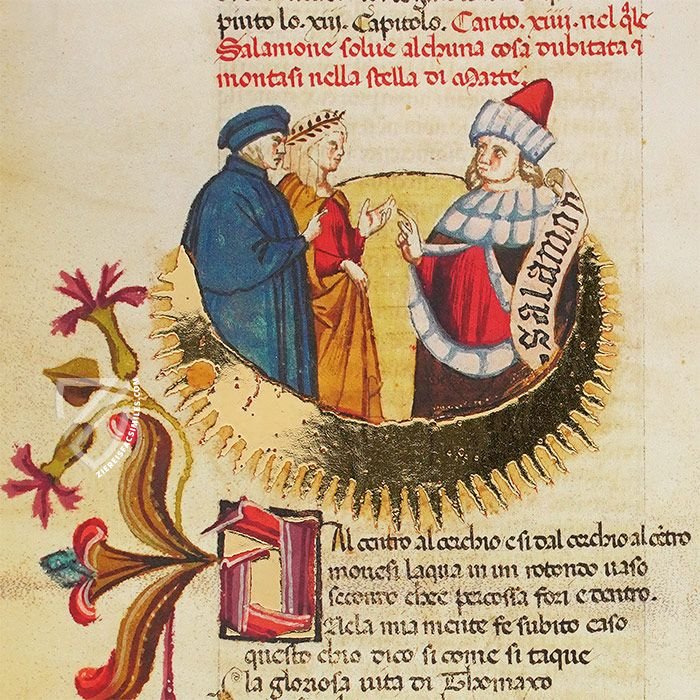
Divine Comedy - Padua 67 Manuscript
Opening Page
The author portrait in the upper left corner, which is styled after a typical portrayal of St. Jerome, shows Dante in a studiolo, a small study for reading, writing, and meditation. Beneath him, a Splendid “N” initial with a glimmering diamond-patterned gold leaf background introduces the text of the Inferno, which is neatly written in two columns.
The bas-de-page miniature is so faded that one could easily miss it. It depicts the meeting of Dante and Virgil on Maundy Thursday, when the author/protagonist finds himself lost in a dark wood where he is attacked by three beasts: a lion, a leopard, and a she-wolf representing self-indulgent, violent, and malicious sins. He is saved by Virgil, who leads him out of the wood and into the underworld.
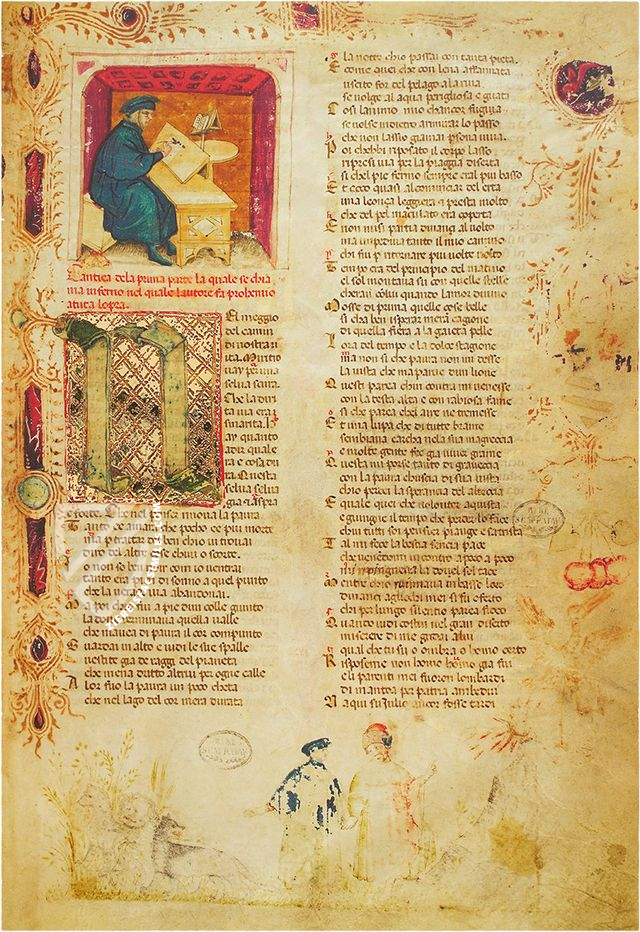
#1 Divina Commedia degli Obizzi
Language: Italian
(3,000€ - 7,000€)
- Treatises / Secular Books
- Apocalypses / Beatus
- Astronomy / Astrology
- Bestiaries
- Bibles / Gospels
- Chronicles / History / Law
- Geography / Maps
- Saints' Lives
- Islam / Oriental
- Judaism / Hebrew
- Single Leaf Collections
- Leonardo da Vinci
- Literature / Poetry
- Liturgical Manuscripts
- Medicine / Botany / Alchemy
- Music
- Mythology / Prophecies
- Psalters
- Other Religious Books
- Games / Hunting
- Private Devotion Books
- Other Genres
- Afghanistan
- Armenia
- Austria
- Belgium
- Belize
- Bosnia and Herzegovina
- China
- Colombia
- Costa Rica
- Croatia
- Cyprus
- Czech Republic
- Denmark
- Egypt
- El Salvador
- Ethiopia
- France
- Germany
- Greece
- Guatemala
- Honduras
- Hungary
- India
- Iran
- Iraq
- Israel
- Italy
- Japan
- Jordan
- Kazakhstan
- Kyrgyzstan
- Lebanon
- Liechtenstein
- Luxembourg
- Mexico
- Morocco
- Netherlands
- Palestine
- Panama
- Peru
- Poland
- Portugal
- Romania
- Russia
- Serbia
- Spain
- Sri Lanka
- Sweden
- Switzerland
- Syria
- Tajikistan
- Turkey
- Turkmenistan
- Ukraine
- United Kingdom
- United States
- Uzbekistan
- Vatican City
- A. Oosthoek, van Holkema & Warendorf
- Aboca Museum
- Ajuntament de Valencia
- Akademie Verlag
- Akademische Druck- u. Verlagsanstalt (ADEVA)
- Aldo Ausilio Editore - Bottega d’Erasmo
- Alecto Historical Editions
- Alkuin Verlag
- Almqvist & Wiksell
- Amilcare Pizzi
- Andreas & Andreas Verlagsbuchhandlung
- Archa 90
- Archiv Verlag
- Archivi Edizioni
- Arnold Verlag
- ARS
- Ars Magna
- ArtCodex
- AyN Ediciones
- Azimuth Editions
- Badenia Verlag
- Bärenreiter-Verlag
- Belser Verlag
- Belser Verlag / WK Wertkontor
- Benziger Verlag
- Bernardinum Wydawnictwo
- BiblioGemma
- Biblioteca Apostolica Vaticana (Vaticanstadt, Vaticanstadt)
- Bibliotheca Palatina Faksimile Verlag
- Bibliotheca Rara
- Boydell & Brewer
- Bramante Edizioni
- Bredius Genootschap
- Brepols Publishers
- British Library
- C. Weckesser
- Caixa Catalunya
- Canesi
- CAPSA, Ars Scriptoria
- Caratzas Brothers, Publishers
- Carus Verlag
- Casamassima Libri
- Centrum Cartographie Verlag GmbH
- Chavane Verlag
- Christian Brandstätter Verlag
- Circulo Cientifico
- Club Bibliófilo Versol
- Club du Livre
- CM Editores
- Collegium Graphicum
- Collezione Apocrifa Da Vinci
- Comissão Nacional para as Comemorações dos Descobrimentos Portugueses
- Coron Verlag
- Corvina
- CTHS
- D. S. Brewer
- Damon
- De Agostini/UTET
- De Nederlandsche Boekhandel
- De Schutter
- Deuschle & Stemmle
- Deutscher Verlag für Kunstwissenschaft
- DIAMM
- Droz
- E. Schreiber Graphische Kunstanstalten
- Ediciones Boreal
- Ediciones Grial
- Ediclube
- Edições Inapa
- Edilan
- Editalia
- Edition Deuschle
- Edition Georg Popp
- Edition Leipzig
- Edition Libri Illustri
- Editiones Reales Sitios S. L.
- Éditions de l'Oiseau Lyre
- Editions Medicina Rara
- Editorial Casariego
- Editorial Mintzoa
- Editrice Antenore
- Editrice Velar
- Edizioni Edison
- Egeria, S.L.
- Eikon Editores
- Electa
- Emery Walker Limited
- Enciclopèdia Catalana
- Eos-Verlag
- Ephesus Publishing
- Ernst Battenberg
- Eugrammia Press
- Extraordinary Editions
- Fackelverlag
- Facsimila Art & Edition
- Facsimile Editions Ltd.
- Facsimilia Art & Edition Ebert KG
- Faksimile Verlag
- Feuermann Verlag
- Folger Shakespeare Library
- Franco Cosimo Panini Editore
- Friedrich Wittig Verlag
- Fundación Hullera Vasco-Leonesa
- G. Braziller
- Gabriele Mazzotta Editore
- Gebr. Mann Verlag
- Gesellschaft für graphische Industrie
- Getty Research Institute
- Giovanni Domenico de Rossi
- Giunti Editore
- Graffiti
- Grafica European Center of Fine Arts
- Guido Pressler
- Guillermo Blazquez
- Gustav Kiepenheuer
- H. N. Abrams
- Harrassowitz
- Harvard University Press
- Helikon
- Hendrickson Publishers
- Henning Oppermann
- Herder Verlag
- Hes & De Graaf Publishers
- Hoepli
- Holbein-Verlag
- Houghton Library
- Hugo Schmidt Verlag
- Idion Verlag
- Il Bulino, edizioni d'arte
- ILte
- Imago
- Insel Verlag
- Insel-Verlag Anton Kippenberger
- Instituto de Estudios Altoaragoneses
- Instituto Nacional de Antropología e Historia
- Istituto dell'Enciclopedia Italiana - Treccani
- Istituto Ellenico di Studi Bizantini e Postbizantini
- Istituto Geografico De Agostini
- Istituto Poligrafico e Zecca dello Stato
- Italarte Art Establishments
- Jan Thorbecke Verlag
- Johnson Reprint Corporation
- Josef Stocker
- Josef Stocker-Schmid
- Jugoslavija
- Karl W. Hiersemann
- Kasper Straube
- Kaydeda Ediciones
- Kindler Verlag / Coron Verlag
- Kodansha International Ltd.
- Konrad Kölbl Verlag
- Kurt Wolff Verlag
- La Liberia dello Stato
- La Linea Editrice
- La Meta Editore
- Lambert Schneider
- Landeskreditbank Baden-Württemberg
- Leo S. Olschki
- Les Incunables
- Liber Artis
- Library of Congress
- Libreria Musicale Italiana
- Lichtdruck
- Lito Immagine Editore
- Lumen Artis
- Lund Humphries
- M. Moleiro Editor
- Maison des Sciences de l'homme et de la société de Poitiers
- Manuscriptum
- Martinus Nijhoff
- Maruzen-Yushodo Co. Ltd.
- MASA
- Massada Publishers
- McGraw-Hill
- Metropolitan Museum of Art
- Militos
- Millennium Liber
- Müller & Schindler
- Nahar - Stavit
- Nahar and Steimatzky
- National Library of Wales
- Neri Pozza
- Nova Charta
- Oceanum Verlag
- Odeon
- Orbis Mediaevalis
- Orbis Pictus
- Österreichische Staatsdruckerei
- Oxford University Press
- Pageant Books
- Parzellers Buchverlag
- Patrimonio Ediciones
- Pattloch Verlag
- PIAF
- Pieper Verlag
- Plon-Nourrit et cie
- Poligrafiche Bolis
- Presses Universitaires de Strasbourg
- Prestel Verlag
- Princeton University Press
- Prisma Verlag
- Priuli & Verlucca, editori
- Pro Sport Verlag
- Propyläen Verlag
- Pytheas Books
- Quaternio Verlag Luzern
- Reales Sitios
- Recht-Verlag
- Reichert Verlag
- Reichsdruckerei
- Reprint Verlag
- Riehn & Reusch
- Roberto Vattori Editore
- Rosenkilde and Bagger
- Roxburghe Club
- Salerno Editrice
- Saltellus Press
- Sandoz
- Sarajevo Svjetlost
- Schöck ArtPrint Kft.
- Schulsinger Brothers
- Scolar Press
- Scrinium
- Scripta Maneant
- Scriptorium
- Shazar
- Siloé, arte y bibliofilia
- SISMEL - Edizioni del Galluzzo
- Sociedad Mexicana de Antropología
- Société des Bibliophiles & Iconophiles de Belgique
- Soncin Publishing
- Sorli Ediciones
- Stainer and Bell
- Studer
- Styria Verlag
- Sumptibus Pragopress
- Szegedi Tudomànyegyetem
- Taberna Libraria
- Tarshish Books
- Taschen
- Tempus Libri
- Testimonio Compañía Editorial
- Thames and Hudson
- The Clear Vue Publishing Partnership Limited
- The Facsimile Codex
- The Folio Society
- The Marquess of Normanby
- The Richard III and Yorkist History Trust
- Tip.Le.Co
- TouchArt
- TREC Publishing House
- TRI Publishing Co.
- Trident Editore
- Tuliba Collection
- Typis Regiae Officinae Polygraphicae
- Union Verlag Berlin
- Universidad de Granada
- University of California Press
- University of Chicago Press
- Urs Graf
- Vallecchi
- Van Wijnen
- VCH, Acta Humaniora
- VDI Verlag
- VEB Deutscher Verlag für Musik
- Verlag Anton Pustet / Andreas Verlag
- Verlag Bibliophile Drucke Josef Stocker
- Verlag der Münchner Drucke
- Verlag für Regionalgeschichte
- Verlag Styria
- Vicent Garcia Editores
- W. Turnowski Ltd.
- W. Turnowsky
- Waanders Printers
- Wiener Mechitharisten-Congregation (Wien, Österreich)
- Wissenschaftliche Buchgesellschaft
- Wissenschaftliche Verlagsgesellschaft
- Wydawnictwo Dolnoslaskie
- Xuntanza Editorial
- Zakład Narodowy
- Zollikofer AG

